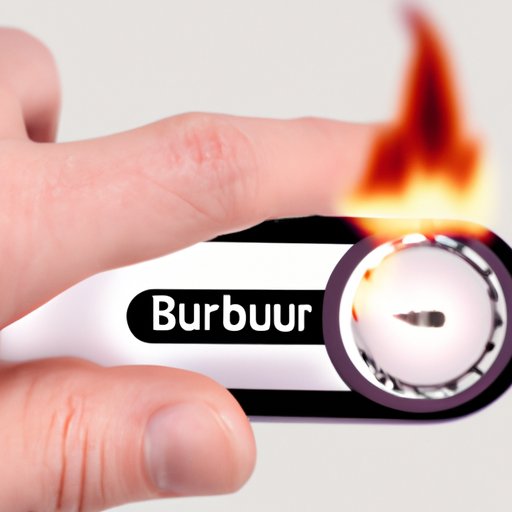
Introduction
Trying to track your caloric burn can be an overwhelming task, but it’s an essential one for anyone looking to establish a healthy lifestyle or achieve fitness goals. Whether you’re trying to lose weight, gain muscle, or just maintain overall health, understanding how many calories you burn is vital information. In this article, we’ll explore how to estimate your caloric burn rate, track your workouts, and understand the factors that affect your caloric burn, so you can use this knowledge to achieve your health and fitness goals.
Counting Calories: A Beginner’s Guide to Estimating Your Caloric Burn Rate
Before we dive into tracking our workouts and understanding factors that affect caloric burn, let’s start with the basics. First, let’s cover why it’s important to know your caloric burn rate. By understanding your body’s caloric burn rate, you can make informed decisions about your diet and exercise routine. For example, if you’re trying to lose weight, you need to create a caloric deficit, which means burning more calories than you consume. On the other hand, if you’re looking to gain muscle, you may need to consume more calories than you burn to provide the necessary energy for muscle growth.
To calculate your caloric burn rate, you must first determine your basal metabolic rate (BMR). BMR is the number of calories your body burns at rest to support vital functions like breathing and circulation. Many online calculators can help you determine your BMR, but you can also use formulas like the Harris-Benedict Equation. Once you’ve determined your BMR, you can estimate your daily caloric burn based on your lifestyle and physical activity. On average, a sedentary person will burn fewer calories a day than someone with an active lifestyle.
Tracking Your Workouts: A Step-by-Step Guide to Calculating Your Caloric Burn
Now that you’ve estimated your daily caloric burn let’s explore how to track your workouts to get a more accurate estimate of your caloric burn. There are several ways to track your workouts for caloric burn estimates, including heart rate monitors, fitness apps, and fitness trackers. These tools use factors like heart rate, distance, and time to estimate your caloric burn for each workout.
To use these tools effectively, you’ll need to input your personal details like age, height, and weight to ensure accurate recommendations. For example, a 30-minute run may result in a different caloric burn estimate if you are shorter, heavier, and older than someone who is taller, lighter, and younger.
Beyond the Treadmill: How Different Types of Exercise Impact Your Caloric Burn
It’s essential to note that not all exercises will have the same caloric burn. Different types of exercise impact caloric burn differently. For example, high-intensity interval training may burn more calories in a shorter amount of time than a slow jog. Examples of other high-intensity exercises include weight lifting, plyometrics, and boxing. But not everyone may be suited or interested in such high-intensity sports. Regular exercises such as walking, swimming, or cycling can be equally beneficial, especially when done consistently.
The type of movement you perform can also impact your caloric burn. For example, the same person may burn more calories while running uphill than running on a flat surface. Add a resistance band to your walk/jog routine for extra resistance. Engaging in different exercises can help you keep your workout routine fresh and exciting while optimizing caloric burn.
Factors That Affect Your Caloric Burn: Why One Size Does Not Fit All
It’s essential to understand that various factors affect your body’s caloric burn rate. Age, genetics, gender, and metabolism all play a role in determining an individual’s caloric burn rate. Men typically require more calories than women due to their higher muscle mass and lower body fat percentage. Genetics also play a role in determining an individual’s BMR, with some people naturally burning more calories than others. As we age, our metabolism naturally slows down, which may impact caloric burn rates.
It’s essential to consider your individual factors when making adjustments to your diet and exercise routine. For example, adjusting your meals for your caloric burn rate and metabolism can help achieve your health goals.
How to Use Your Caloric Burn Rate to Achieve Your Health and Fitness Goals
With an understanding of your caloric burn rate, you can use this knowledge to achieve your health and fitness goals. If your goal is to lose weight, you’ll need to create a caloric deficit by burning more calories than you consume. Tracking your caloric intake can help you ensure you’re eating the right amount each day while still getting the necessary nutrients. Incorporating exercise into your routine will also help you burn more calories and achieve your weight loss goals.
If you’re looking to gain muscle, you may need to consume more calories than you burn to create the energy your muscles need for growth. Strength training exercises like weightlifting will help you gain muscle while increasing your caloric burn rate.
Remember to track your progress regularly and make adjustments as needed. Adjusting caloric intake to your caloric burn rate and modifying your exercise routine can help you achieve success.
Conclusion
Tracking your caloric burn may seem intimidating at first, but with this guide, you now have all the information you need to get started. Start by calculating your BMR and estimating your daily caloric burn. Use this information to track your workouts, incorporating a variety of exercises to maximize your caloric burn rate. Keep in mind that individual factors like age, genetics, and metabolism can affect your caloric burn rate, and make adjustments to your diet and exercise routine accordingly. With this knowledge, you can set and achieve your health and fitness goals.




